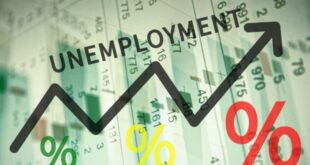The two-county region is definitely struggling, but there’s a reason for some optimism as 2020 comes to a close.
There’s no arguing that the Inland Empire economy isn’t anywhere close to the top of its game as 2020 comes to a close, having taken a severe beating from COVID-19 during the past 10 months.
The region lost 110,600 jobs from October 2019 to October 2020, according to the UC Riverside School of Business Center for Economic Forecasting and Development.
By far the sector that took the biggest hit was leisure and hospitality, which had 27,600 fewer workers in October than it did exactly one year earlier. That was a drop of 27.6 percent.
The region’s unemployment rate in November was 7.9 percent, down from 8.7 percent in October but well above the 3.7 percent recorded in November 2019, according to data compiled by the center.
So, the Inland economy -which was in good shape before the pandemic hit in March – has much ground to make up as it heads into 2021. But its situation might not be as dire as it appears at first glance.
Yes, the region lost more than 110,000 jobs from October of last year to October of this year, but it has recovered more than 93,000 of those positions since April, leaving it ahead of California in job growth.
Its unemployment rate is also slightly less than the state’s, and it added roughly 28,300 workers between October 2019 and October 2020, a 1.4 percent year-over-year increase.
Also, the increase in e-commerce has helped keep the Inland Empire’s transportation and warehousing sectors strong. Payrolls have expanded by 100 employees over the last year, compared with a 3.3 percent decline statewide, according to the study.
But the best news for the Inland economy is the introduction of multiple vaccines onto the market that, in mid-December, began being administered in the Inland Empire and all over the world.
This development was so big that the business center on Dec. 17 – just as the second surge of COVID-19 hit – issued a report on their potential impact on the local economy,
The report declared that the vaccines now on the market were the first signs of the pandemic’s end, although it makes no prediction on when that might happen.
“While we’ve always known that the economic recovery hinged on controlling the virus, genuine containment has been a wildcard until now. Because we now have effective vaccines in hand, the path to economic recovery is more certain. Governments and businesses can get a sense of the timeline for returning to normalcy.”
Taner Osman PhD, Manager, Regional and Sub-Regional Analysis and one of the report’s authors at UC Riverside School of Business Center for Economic Forecasting and Development
The report predicts that “significant job gains, including within the Inland Empire’s hardest-hit industries, should begin in earnest in the coming months.”
Unlike the Great Recession, this economic slowdown was caused by an outside force, not by structural flaws within the economy. That means when the virus is gotten rid of the economy should recover quickly, Osman said
The fact that a vaccine is the key to getting the economy back on track is indisputable, but at what pace that will happen is anyone’s guess, said Robert Kleinhenz, a Long Beach-based economic consultant and former principal economist with Beacon Economic in Los Angeles.
“The Inland Empire has recovered some jobs, and that’s a good sign,” Kleinhenz said. “We will see a jobs recovery, but I think it will be a slow one. I don’t think we will start to notice it until 2022.
“Logistics is doing well, to no one’s surprise,” he added. “It will have to carry much of the load for a while next year. It’s also not a good sign that the government is cutting jobs.”
The travel and hospitality sector, especially restaurants, will continue to take a beating in 2021, although that trend might slow in the second half of the year, according to Kleinhenz.
One key to a sustained recovery is interest rates remaining low.
“The housing market hasn’t skipped a beat, and that’s because the Federal Reserve has kept interest rates down,” Kleinhenz said. “Because of that, a lot of people were able to save their money and eventually buy a house.”
Consumer spending in the Inland Empire should increase in the second half of 2021, at which point life will start to look like it did before the pandemic hit.
“I’m cautiously optimistic that 2021 is going to be a good year,” Kleinhenz said. “At some point I believe we will see people going to movies and museums and eating in restaurants. The vaccines are on the market and they’re the solution to the problem, but they have to be rolled out widely.”
 IE Business Daily Business news for the Inland Empire.
IE Business Daily Business news for the Inland Empire.


